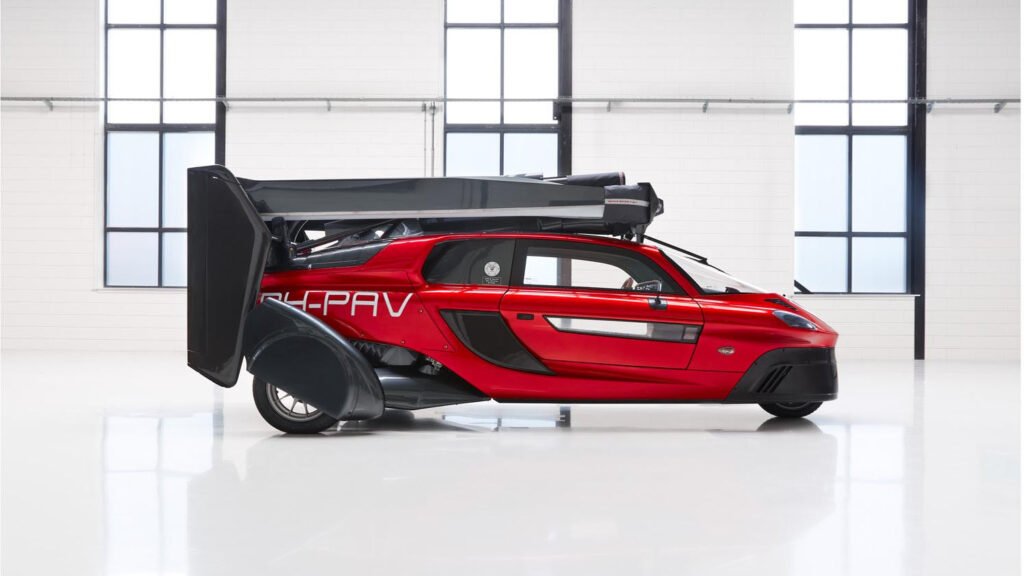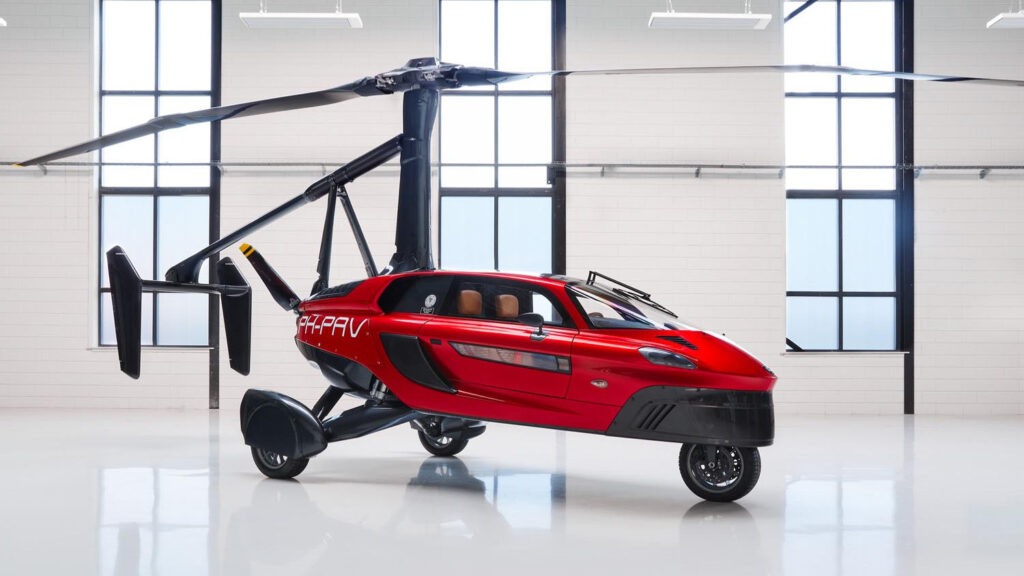The design and configuration of the PAL-V flying car was built on a solid foundation of PLM and cloud, using technology from PTC
When it comes to technology, the Dutch have always been pioneers. Pendulum clocks, metronomes, microscopes and yachts can all be attributed to brilliant minds from the Netherlands. PAL-V continues the long tradition of Dutch ingenuity, adding yet another potentially world-changing invention to the list: the flying car.
PAL-V (Personal Air and Land Vehicle) is an innovative company founded in 2008 that is aiming to bring together the best thinking from the aviation and automobile industries.
The idea behind the company was born when one of its co-founders began flying in 1999. He faced a hassle experienced by many pilots. He would drive to the hangar in order to depart by plane, only to arrive at his destination in need of a car.
Unpredictable weather conditions can add further complications, if pilots are unable to fly back safely to their original point of departure.
More than 20 years on, PAL-V offers customers a new way to ‘fly/drive’, with the goal of making aviation more practical for everyday use.
Says PAL-V CEO and co-founder Robert Dingemanse: “Everyone has been a child and stood looking at the sky, thinking, ‘I want to fly. I want to be as free as a bird.’ The flying car today is made up of existing and proven technologies. It can be certified within existing regulations. When we started, we were just building a flying car. Now we’re recognised as the leader in the future of flying mobility.”
PAL-V – Rapid progress, advanced tech
Within the first few years following its founding, PAL-V progressed its flying car prototype by combining the structures of a three-wheeled car and a gyroplane – a type of rotorcraft that uses an unpowered top rotor to deliver lift, with thrust provided independently by an engine-driven propeller.
As this prototype work unfolded, the team realised that its needs were outgrowing its technology capabilities. The earliest work was performed entirely on-site by a small team of 10 people. By 2014, the team had grown to 15, but its systems and methods hadn’t changed. Version control and configuration management of products and designs were still performed by individuals, using a manual naming and numbering system. Fast-forward to today, and the team numbers over 40 people and is continuing to grow rapidly.
In addition, the European Union Aviation Safety Agency (EASA) lays down strict regulations for rotorcraft design and operation. Moving from an experimental prototype to actual production would require PAL-V to ensure its data was traceable and complied with strict rules.
PAL-V recognised that, in order to grow the company, continue daily operations at scale, and abide by aerospace regulations, it would need a stronger technology foundation to manage complete design specifications in a controlled manner.
PAL-V – Up in the clouds
This led PAL-V on a hunt for a product lifecycle management (PLM) system that could provide firm foundations for good data governance and compliance. PTC’s Windchill SaaS and PTC Cloud proved natural fits for its product development needs. Windchill provides an authoritative ‘single source of truth’ for data and its open architecture supports integration with other enterprise systems. That makes it a good cornerstone for a productdriven digital thread. The SaaS offering, meanwhile, makes it easier for customers to configure, scale and secure its PLM instance. It also supports collaboration and agility across distributed teams, including remote work environments.
Plus, a key factor in PAL-V’s decision to use Windchill was that it was the only out-of-the-box implementation they found that closely aligned with the CM2 methodology, a global enterprise standard for change and configuration management.
When product changes are required, Windchill enables users to capture issues or enhancements, document and implement related updates, and send out a prioritised change notice to all stakeholders. And because it connects with other systems, all affected items are automatically updated across the organisation.
Using the PTC Cloud, meanwhile, PAL-V gets peak performance, functionality and security, as well as the opportunity to focus on high-value business opportunities, because the administrative burden and hardware costs associated with on-site systems are avoided.

Regulations in mind
PAL-V designed its flying car with the regulations with which it would need to comply firmly in mind. Before implementing Windchill SaaS and PTC Cloud, maintaining compliance and making design changes required manual processes and paperwork. Now, processes are digitised and change management stands at the forefront of driving compliance.
“Compliance requires a lot of paperwork, which is now digital,” says Jeroen Klein Lankhorst, IT manager and PLM implementer at PAL-V. “Aviation is all about making sure everything is safe and can be traced back to who supplied and designed it, to improve it and make it safer. That’s what Windchill SaaS and PTC Cloud enable us to do.”
In fact, PAL-V established a foundation for compliance across the entire company. By having just one system implemented in the right way, it can successfully comply with the majority of regulations all at once.
“The PTC system does 80% to 90% of everything we need for complying with product definition requirements,” says Klein Lankhorst. “In that way, it lays a foundation for compliance across the whole company – and that’s really important.”
With the PLM platform, PAL-V can focus on what matters most: driving value and growing its business, he adds: “We’ve grown quite fast, and we expect to involve a lot of partners in the future, whether it’s maintenance partners or flight schools. We need a solid system to grow on, and Windchill provides that.”

PAL-V – Collaboration hub
PAL-V knew that continued growth would create the need for more data storage and advanced sharing capabilities – but its IT systems couldn’t scale to meet these needs without imposing a significant burden on the company’s IT team.
That led to the decision to invest in the PTC Cloud to manage and store data. The flexibility of this was crucial to PAL-V’s mission, and it worked with the PTC Cloud team, as well as an integration partner, to customise and configure its platform with all the functionality needed. Furthermore, PTC Cloud offered the high degree of security that PAL-V needed to keep its proprietary design specifications safe.
In its production process, PAL-V is now able to involve suppliers through the PTC platform. ThingWorx Navigate for PLM data allows not just members of its own team, but also third-party collaborators, such as outside design firms, to securely access data whenever needed and without having to change any infrastructure.
Close collaboration with PTC’s service managers has helped when it comes to solving issues and adding new functionality to the system. For example, when a caching issue wasn’t resolved in the testing environment, PTC service managers helped PAL-V identify and quickly correct it. Even post-implementation, PAL-V engineers stay in regular contact with the PTC Cloud team.
Foundation for future growth
With its new PLM platform in place, bolstered by the convenience of PTC Cloud, PAL-V is on target to continue its 20% annual growth rate. More importantly, its first product launch is just around the corner.
In 2022, PAL-V will commence production of about 90 PAL-V Liberty Pioneer editions of its flying car. The company already has pre-orders from 11 countries and around 30 orders from the Netherlands alone. After the initial run of the Pioneer edition, it will continue production with the PAL-V Liberty Sport, the standard version of the vehicle.
Technology capabilities are expanding at the company, too, with PAL-V planning to incorporate PTC’s ThingWorx IIoT (Industrial Internet of Things) capabilities. These might enable, for example, flight data tracking systems in PAL-V machines, predictive maintenance for customers, and the use of data collected from Pioneers to make safety and performance improvements.
Says Klein Lankhorst: “The cloud component – the fact that we have a compliant foundation for our data – gives us a lot of options down the road.” With new breakthroughs in product design and engineering sure to follow, it looks like the sky’s the limit for PAL-V.








